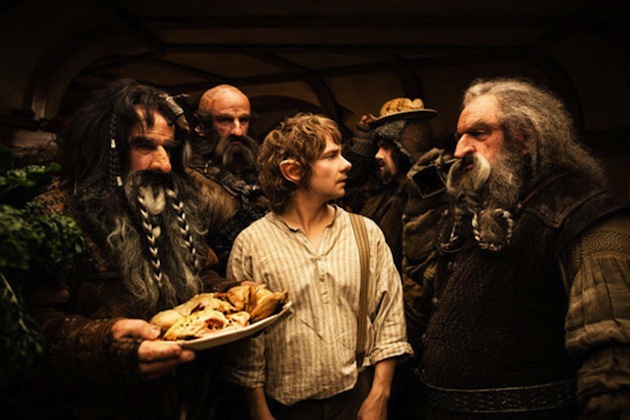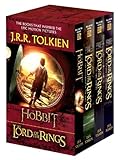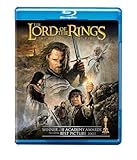The Hobbit: An Unexpected Trilogy

When Peter Jackson announced ‘The Hobbit’ would be two movies, no one was surprised. When he announced it was going to be three movies, the decision seemed more capitalistic than artistic.
I’ve already complained at length about the decision to split The Hobbit into three films; a decision which makes about as much sense as making Green Eggs and Ham into a 13 episode HBO series, or turning the game Hungry Hungry Hippos into a movie. Oh, anyway, An Unexpected Journey is finally here so it’s time to make an informed judgement. Well, a semi-informed judgement.
It seems that there’s simply not enough material in the novel to justify this money-making move to split it into three films. As Chuck explains in his great review, this first instalment feels aimless and meandering as a result; a gang of increasingly annoying dwarves go from place to place, battling CGI monster after CGI monster. By the time the credits roll (or whatever it is that 3D credits do; bulge, perhaps) it’s deeply unsatisfying, as if we’ve only watched a third of a film. Because that’s exactly what we’ve done.
This was never a problem for The Lord of the Rings trilogy, all three films of which were proper movies in their own right, each with a beginning, middle and end. After all, each one was based on a single novel. Yes, The Fellowship of the Ring ended with the beginning of an adventure, but there was still a sense of finality to the piece. An Unexpected Journey, on the other hand, feels like a chopped up portion of one movie.
At no point in The Lord of the Rings do you roll your eyes at a big CGI goblin with a stupid voice (Barry Humphries), or scratch your head at a crowbarred-in scene with Saruman (Christopher Lee), or curse a load of Dwarves under your breath. In fact, if you find the Dwarves’ comic antics anything less than riotously funny, then much of An Unexpected Journey just feels tedious. Too much time is spent introducing them in the Shire (the most boring place in Middle-earth) before wandering aimlessly from battle to battle, with some exposition here and a cutesy CGI hedgehog there. The bloated nature of it all highlights the problem of splitting The Hobbit into multiple movies; there’s not enough material to spread out over three films (“like butter scraped over too much bread,” to quote Bilbo) and so what we get is a lot of padding. A lot of soft, cushy padding.
If you were to watch An Unexpected Journey without watching the following two instalments, it would just feel like watching a series of events with no satisfying conclusion. A film should work by itself. You shouldn’t have to read the books or see other movies for it to make sense. The Harry Potter films are particularly bad in this respect; much of them require familiarity with the source material, and by splitting the final book into two movies, we get a penultimate instalment which goes absolutely nowhere. A single film should be a self-contained, fully coherent piece of work.
It would be odd to only watch, say, the third part of a trilogy, but it should still be possible. Again, The Lord of the Rings achieves this; The Return of the King works as a standalone film. Partly because it’s about as long as three movies. But even with its lengthy running time, An Unexpected Journey doesn’t feel like a fully satisfying movie and that is a problem. It’s a problem with splitting what should be single films into several parts, which allows filmmakers to get away with failing to successfully adapt material.
As I’ve argued, if you can’t fit your adaptation into a single film you have already failed. But now audiences are going to have to pay three times as much money for what may prove to be three unsatisfying The Hobbit movies. Why should this be acceptable in the world of film, when it’s thankfully not anywhere else? It’s like if a band were to release one album with all the guitar and bass parts, and then another the following year with all the drums and vocals. Or like reading The Hobbit, only for it to painfully snap shut on your fingers once you get a third of the way through. It seems that films no longer need to be actual films, and can get away with laziness and incoherence to make even more money.
Thanks to this greedy trend, what could have been a children’s fantasy classic looks more likely to become the disappointing follow up to one of the greatest trilogies ever made. The whole thing makes you wish that Guillermo del Toro had stayed in the director’s chair, making it all a little less cosy and a little less long. And if anyone from HBO is interested in my Green Eggs and Ham show, we’ll talk.
 CliqueClack
CliqueClack






I agree with pretty much most everything you said (though I did not enjoy the original LOTR trilogy nearly as much as you), with one major exception:
I don’t think you needed to have read the HP books to be able to understand/follow the movies; I know plenty of folks who never read the books that enjoyed the films a great deal.
I have never read any of the books, and enjoyed the LOTR trilogy very much. The Hobbit even without reading the book, seemed way too padded and strayed from the main story.
I don’t totally agree. I do agree that there wasn’t a satisfying end, but I would not say there is no arc to this movie. It’s Bilbo belonging to the party. It’s Bilbo proving his worth. In it’s self it’s a stronger Arc than Fellowships. And you speak as if they are just covering The Hobbit. Yes this is the Hobbit, but It is also I believe the Resurrection of The Witch King and The story surrounding the Omega(sp). This movie is just a setup. Jackson wants to make a story that is coherent and consistent over 3 movies. This movie has to give all the known’s and set up the themes for the next 2 movies. And you know what happens at the end of the next film? The end of the Hobbit. How are they going to fill a whole other movie after the Hobbit is done with? You have seen it in this movie, and Radagast Will be a big part. So sit back and enjoy the part of the story that wasn’t really par of the Hobbit but is something that is it’s own story. If you want to say that they don’t mesh well by the 3rd movie, that might be a good criticism. But you are ignoring the basic established fact that they are telling more than the hobbit. Other than that it was a fine setup, just unsatisfying because SO much is set up with few resolutions. How great this movie is reliant on the last 2 parts and unfortunately it’s a long gap between the movies.
Also, it’s the LAST time ANYONE will ever touch token’s work for a Film for a long time. Token’s relatives are justifiably pissed because the studios are avoiding paying for the movies. They had to go to court just to get a fraction of the money they were owed up till that point getting only around 50k. Their agreement was 7.5%. Doing this, is the only way this story EVER gets told because the Rights are going to be gone for a long time.
However, it’s a largely embellished and occasionally inverted arc for Bilbo, the nadir of which was him basically stealing the ring practically out of Gollum’s pocketses, rather than fairly claiming an abandoned trinket (IIRC that even retcons what happened in the previous trilogy). With all the appendices and invented scenes grafted on, it feels like Bilbo occupies about 40% of the film proper, and even that time takes a backseat to Thorin’s much more important backstory and character arc and his manufactured nemesis’s backstory and sinister machinations (I’m not even going to touch what they did to turn Thorin II into Aragorn I).
I believe the second film will end with Smaug, and the third will include the aftermath, tensions among the free peoples, the Battle of Five Armies, and “Back Again” to The Shire. It’s not going to be all about the expulsion of the Necromancer from his stronghold, which will probably be dribbled out over both films, grinding The Hobbit storyline to a halt each time.
All in all, there’s a reason this material was relegated to the appendices and Unfinished Tales, that Radagast (and Alatar and Pallando) was never a central figure, and that Tolkien eventually abandoned his attempt to rewrite much of The Hobbit to match the later trilogy.
I’m unsure to what Omega or Resurrection of the Witch-king (who’s been openly warring on men and elves for the past 1,641 years) refer.
Since Dan mentioned the White Council, I have to quote my favorite line from Robbie Collin’s review in The Telegraph: “Here [in Rivendell], Gandalf has an interminable conversation with Galadriel (Cate Blanchett), Saruman (Christopher Lee) and Elrond (Hugo Weaving), which gets so boring that Bilbo and the dwarves leave without them.”
**Reposted for completion**
It took me a LONG while to gather this information, longer than I would like to admit. But the simple answer to this is that Peter Jackson is not adapting The Hobbit at all because The Hobbit was never meant to be Part of the LTOR saga, just adapted to it later. What we are getting is The Quest of Erebor and the short stories in The Unfinished Tales. All of this is being adapted onto the story of The Hobbit mainly because Quest of Erebor is The Hobbit, just with more stuff and adapted to fit into LTOR properly. I received this information from comic artist Dresden Codak’s tumblr blog. I’ll put the link at the bottom. He goes into much more detail about it and the history of the 7 Dark Lords and knows a literal ton. Currently he is breaking down the Silmarillion chapter by chapter. It’s very interesting reading material. And when I posted that comment in the sites review, I was looking for this information but it is like a little piece of hell tiring to find.
https://dresdencodak.tumblr.com/post/38238171936/where-the-extra-content-in-the-hobbit-came-from
Missed the timer on edit, but I wanted to say that I was wrong on the Resurrection of the Witch King, learned that while looking for this stuff again. But the Omega story has entirely to do with Ratagast and his Staff. Where he got it, it’s jewel ect. I’ve seen this story somewhere before, and mentioned in a Morning Spoilers article. But it’s the darkness that is blanketing the forest. I don’t think Omega was the name, but I swear it started with an O. It’s going to come to me and then I’m going to hit myself.
You are definitely well educated on this issue. Thanks for expressing your opinions with us in such depth. Have a great morning!